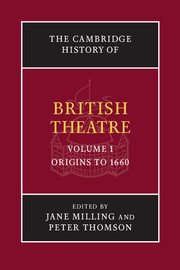Book contents
- Frontmatter
- PART I PRE-ELIZABETHAN THEATRE
- 1 From Roman to Renaissance in drama and theatre
- 2 Faith, pastime, performance and drama in Scotland to 1603
- 3 The Bible as play in Reformation England
- 4 Drama in 1553: continuity and change
- PART II ELIZABETHAN THEATRE
- PART III JACOBEAN AND CAROLINE THEATRE
- Works Cited
- Index
- References
3 - The Bible as play in Reformation England
from PART I - PRE-ELIZABETHAN THEATRE
Published online by Cambridge University Press: 28 March 2008
- Frontmatter
- PART I PRE-ELIZABETHAN THEATRE
- 1 From Roman to Renaissance in drama and theatre
- 2 Faith, pastime, performance and drama in Scotland to 1603
- 3 The Bible as play in Reformation England
- 4 Drama in 1553: continuity and change
- PART II ELIZABETHAN THEATRE
- PART III JACOBEAN AND CAROLINE THEATRE
- Works Cited
- Index
- References
Summary
One might suppose that the rise in Bible reading and the literacy it engendered during the English Reformation rendered obsolete the demand for popularly produced biblical plays. For centuries such plays had been among the few means by which the general populace learned about the Bible and its stories, the Catholic church having restricted reading it to those who knew Latin. Indeed, it is widely believed that biblical drama – most notably the ‘mystery cycles’ and other parish- and civic-sponsored scriptural plays – fell rapidly into decline largely because of Protestantism's reverence for the written Word of God and its growing hostility towards image-centred representations of sacred history. These factors, in conjunction with state censorship of religious issues in plays, the theory goes, hastened the drama's development towards secularisation which reached its height of achievement in the urban theatre of Shakespeare and his contemporaries.
Without questioning Protestantism's significant role in the eventual cessation of religious drama as a popular pastime in England in the second half of the sixteenth century, we need to reconsider some of our assumptions about both Protestantism itself and religious – and here specifically biblical – drama. Protestantism was not a fixed, unchanging cultural entity; it produced a range of religious sensibilities and cultural attitudes, some characterised by excessive zeal and iconoclastic tendencies; others more conservative and accommodating of traditional beliefs and practices. This is especially important to keep in mind in the first phase of the Reformation's cultural formation, a period I would extend from about 1530 to 1580, when the relationship between medieval religious and early modern reformed values, beliefs and modes of worship was not everywhere characterised by conflict and opposition.
- Type
- Chapter
- Information
- The Cambridge History of British Theatre , pp. 87 - 115Publisher: Cambridge University PressPrint publication year: 2004
References
- 1
- Cited by



